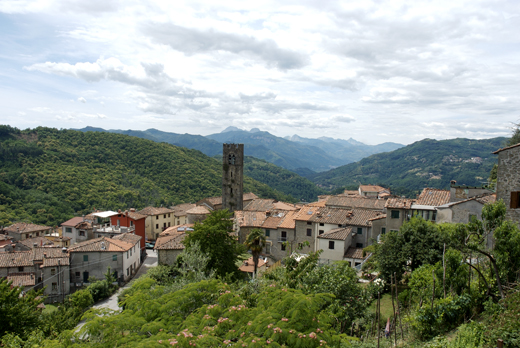
Benabbio is situated 479meters above sea level and its 5 kilometers from Bagni di Lucca.Bruno Cherubini in his book “I Bagni di Lucca” describes it ‘as a hidden town nearly jealous of itself ’ a well fitting description as it’s not on the hills but on the valleyfloor.The road that brings to Benabbio goes on to Collodi and the Valleriana.Thisroad was built at the end of the last century and connects Benabbio with Bagni di Lucca.At the beginning of the road to Benabbio theres a place called Dominillo and theres a beautiful view of the town and the surrounding mountains.Entering Benabbio there’s the square Santa Maria and the parish church Santa Maria Assunta.The church was built in 1338, theres an inscription on the side of the church that looks onto the square.It has three aisles with pillars and ornated capitals,the roof is made with wooden beams.In the apse a triptych of Baldassarre of the late Biagio of Florence commis sioned by the men of Benabbio in 1469,the alterpiece has is its center the Virgin Mary with Child and on the sides two pairs of saints,San Michele e Pietro and San Giovanni Battista e Bartolomeo.In the left hand aisle theres a baptism fountain dated 1564 protected by iron railings dated 1601. There’s alot of value in the church,like the two wooden side alters of the 17thcentury on either side of the main alter, two lampshades in wrought iron, also two wooden statues dated 1394 that represent an angel and Padre di Iacopo della Querica by Piero D’Angelo. Another building worth seeing is the Oratory of S.S Filippo e Giacomo its situated in the square of the primo maggio.The ruins of the castle of Benabbio like Lucchio and Casoli are situated at the top of the village,they are the most important castles of the Val di Lima,lately traces have been found and studied at the University of Pisa. There is also a theatre called ‘Eden’ opened at the end of the 500’s this shows the passion the population had for acting and music, that in 1876 the Philharmonic society of Benabbio was founded. Excavation and research has been done over the past few years on the antique ruins of the castle by the Department of Paleopathology of the University of Pisa. From the 6th July to the 22nd August the third campaign for the excavations will be opened to the public who can assist the archaeologists at work.For information visit the website:www.palepatologia.it/Scavo/Benabbio.php
The History
It’s first remembered in a parchment of 983. Originally it was called Menabia then Menabbio, but no-ones certain where it originates from. Benabbio was owned by the Lupar family, the most representative was known as Lupo,remembered as a poet and known for his connection with Castrucciuo Castracani degli Antelminelli. Lupari had sweared to the town of Lucca to look after anf defend the Apennine Mountains and to make sure no-one trespasses from other provinces,but Lupo showed that he was a violent man and never listened to the orders given to him from Lucca. In 1334there was an outbreak of war between Lucchesi and Florentines, Lupo was ordered to send all of his men to help Castruccio,but he only sent half of them favouring the occupation of the village of Cerbaiola by the Florentines. But at Altopascio the lucchesi beat the florentines then they went to Benabbio to punish Lupo, he was band from the republic and fled to Bologna. But a legend tells that he is buried in a tunnel under the castle; where one can enter a well still existing today. The population was famous for its warlike spirit and where known as the best soldiers in the Val di Lima, and even Lucca used them alot. In 1798 the population made a revolt against the french forcing them to abandon the village. The french philsopher Michel de Montaigne visits Benabbio in the summer of 1581 and he describes it as ‘a village big and beautiful’. In the house that sits on the “Colle di Belvedere in 1837 Luigi Napoleone Bonaparte(Napoleone III) found refuge with the help of duke Carlo Ludovico when he was persued by the King of France Luigi Filippo. Benabbio was the most populated village,in the year 1566 it had 1600 inhabitants. The antique statutes have been lost but two remain of the 18thcentury one in the archives of the town council dated 1781 and one in the archives of the state of Lucca. A major partof the phonic material of the organ is of the 16thcentury but has been rearranged in 1703 as written on the left side of the organ case"ad multiplex custodie/ndum organum hanc/ab aloysio colognora bar/gensi varils incisionibus ornat/am philippo adami rectore/ignatio contrucci operario/a partu virginis anno/1703/stephanus cortopassi de/terelio/et petrus angelus domenici/de/benabbio(fecerunt)arcam”
Famous People
Benabbio was the native birthplace to Father Antonio Cianelli(1753/1827)-author.
Antonio Vivani 1770(died at Lucca 1830)-poet at Rome and wrote verses for the court of the King of Naples.
Rodolfo Pierotti (1845-1909)-engineer,elected 6 times member of parliment(fought for the unity of Italy).
Francesco Cianelli (1838-1910)-teacher in the seminary of Lucca,author of numerous inscriptions.




